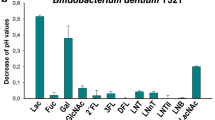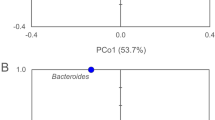Abstract
Bifidobacteria (246 strains in total) were isolated from rectal samples of infants and adult humans and animals, and from intestinal samples of calves. Twenty-five strains grew well on mucin: 20 from infants, two from adults, and three from goatlings. Poor or no growth on mucin was observed in 156 bifidobacterial strains of animal origin. The difference between human and animal isolates in ability to grow on mucin was significant at p < 0.001. Nine human strains with the best growth on mucin were identified as Bifidobacterium bifidum. These strains produced extracellular, membrane-bound, and intracellular mucinases with activities of 0.11, 0.53, and 0.09 μmol/min of reducing sugars per milligram of protein, respectively. Membrane-bound mucinases were active between pH 5 and 10. The optimum pH of extracellular mucinases was 6–7. Fermentation patterns in cultures grown on mucin and glucose differed. On mucin, the acetate-to-lactate ratio was higher than in cultures grown on glucose (p = 0.012). We showed that the bifidobacteria belong to the mucin-fermenting bacteria in humans, but their significance in mucin degradation in animals seems to be limited.
Similar content being viewed by others
References
Abe F, Muto M, Yaeshima T, Iwatsuki K, Aihara H, Ohashi Y, Fujisawa T (2009) Safety evaluation of probiotic bifidobacteria by analysis of mucin degradation activity and translocation ability. Anaerobe 16:131–136
Allen A, Snary D (1972) The structure and function of gastric mucus. Gut 13:666–672
Bayliss CE, Houston AP (1984) Characterization of plant polysaccharide- and mucin-fermenting anaerobic bacteria from human feces. Appl Environ Microbiol 48:626–632
Collmer A, Ried JL, Mount MS (1988) Assay methods of pectic enzymes. In: Wood WA, Kellog ST (eds) Methods in Enzymology, vol 161. Academic, San Diego, pp 329–334
Conway EJ (1957) Microdiffusion analysis and volumetric error, 4th edn. Crosby Lockwood and Son, London, p 277
Corfield AP, Wagner SA, Clamp JR, Kriaris MS, Hoskins LC (1992) Mucin degradation in the human colon: production of sialidase, sialate-O-acetylesterase, N-acetylneuraminate lyase, arylesterase and glycosulfatase activities by strains of fecal bacteria. Infect Immun 60:3971–3978
Crociani F, Alessandrini A, Mucci MM, Biavati B (1994) Degradation of complex carbohydrates by Bifidobacterium spp. Int J Food Microbiol 24:199–210
De Vries W, Stouthamer AH (1968) Fermentation of glucose, lactose, galactose, mannitol, and xylose by bifidobacteria. J Bacteriol 96:472–478
Derrien M, Vaughan EE, Plugge CM, de Vos WM (2004) Akkermansia muciniphila gen. nov., sp. nov., a human intestinal mucin-degrading bacterium. Int J Syst Evol Microbiol 54:1469–1476
Herbert D, Phipps PJ, Strange RE (1971) Chemical analysis of microbial cells. In: Norris JR, Ribbons DW (eds) Methods in microbiology, vol 5B. Academic, London, pp 204–344
Hill RRH (1986) Digestion of mucin polysaccharides in vitro by bacteria isolated from the rabbit cecum. Curr Microbiol 14:117–120
Horowitz MI (1967) Mucopolysaccharides and glycoproteins of the alimentary tract. In: Code CF, Heidel W (eds) Alimentary Canal, vol II. American Physiological Society, Washington (DC), pp 1063–1085
Hoskins LC (1993) Mucin degradation in the human gastrointestinal tract and its significance to enteric microbial ecology. Eur J Gastroen Hepatol 5:205–213
Kandler O (1983) Carbohydrate metabolism in lactic acid bacteria. Antonie Leeuwenhoek 49:209–224
Katayama T, Fujita K, Yamamoto K (2005) Novel bifidobacterial glycosidases acting on sugar chains of mucin glycoproteins. J Biosci Bioeng 99:457–465
Lever M (1977) Carbohydrate determination with 4-hydroxybenzoic acid hydrazide (PAHBAH): effect of bismuth on the reaction. Anal Biochem 81:21–27
Lindstedt G, Lindstedt S, Gustafsson B (1965) Mucus in intestinal contents of germfree rats. J Exp Med 121:201–213
Marounek M, Petr O, Šimůnek J (1993) Monensin has no effect on growth and metabolism of Megasphaera elsdenii. Folia Microbiol 38:383–386
Matsuki T, Watanabe K, Tanaka R, Fukuda M, Oyaizu H (1999) Distribution of bifidobacterial species in human intestinal microflora examined with 16 S rRNA-gene-targeted species-specific primers. Appl Environ Microbiol 65:4506–4512
Orban JI, Patterson JA (2000) Modification of the phosphoketolase assay for rapid identification of bifidobacteria. J Microbiol Meth 40:221–224
Roberton AY, Stanley RA (1982) In vitro utilization of mucin by Bacteroides fragilis. Appl Environ Microbiol 43:325–330
Ruas-Madiedo P, Gueimonde M, Fernández-García M, de los Reyes-Gavilán CG, Margolles A (2008) Mucin degradation by Bifidobacterium strains isolated from the human intestinal microbiota. Appl Environ Microbiol 74:1936–1940
Salyers AA, West SEH, Vercellotti JR, Wilkins TD (1977) Fermentation of mucins and plant polysaccharides by anaerobic bacteria from the human colon. Appl Environ Microbiol 34:529–533
Scardovi V, Trovatelli LD (1965) The fructose-6-phosphate shunt as peculiar pattern of hexose degradation in the genus Bifidobacterium. Ann Microbiol Enzimol 15:19–29
Schrager J (1970) The chemical composition and function of gastrointestinal mucus. Gut 11:450–456
Sgorbati B, Biavati B, Palenzona D (1995) The genus Bifidobacterium. In: Wood BJB, Holzapfel WH (eds) The genera of lactic acid bacteria. Blackie Academic & Professional, London, pp 279–306
Sirotek K, Santos E, Benda V, Marounek M (2003) Isolation, identification and characterization of rabbit caecal mucinolytic bacteria. Acta Vet Brno 72:365–370
Slomiany A, Zdebska E, Slomiany BL (1984) Structures of the neutral oligosaccharides isolated from A-active human gastric mucin. J Biol Chem 259:14743–14749
Slováková L, Dušková D, Marounek M (2002) Fermentation of pectin and glucose, and activity of pectin-degrading enzymes in the rabbit caecal bacterium Bifidobacterium pseudolongum. Lett Appl Microbiol 35:126–130
Tsai HH, Hart CA, Rhodes JM (1991) Production of mucin degrading sulfatase and glycosidases by Bacteroides thetaiotamicron. Lett Appl Microbiol 13:97–101
Vlková E, Nevoral J, Jenciková B, Kopečný J, Godefrooij J, Trojanová I, Rada V (2005) Detection of infant fecal bifidobacteria by enzymatic methods. J Microbiol Meth 60:365–373
Vlková E, Trojanová I, Rada V (2006) Distribution of bifidobacteria in the gastrointestinal tract of calves. Folia Microbiol 51:325–328
Acknowledgments
This research was supported by the Academy of Sciences of the Czech Republic (project AV0Z 5045 0515).
Author information
Authors and Affiliations
Corresponding author
Rights and permissions
About this article
Cite this article
Killer, J., Marounek, M. Fermentation of mucin by bifidobacteria from rectal samples of humans and rectal and intestinal samples of animals. Folia Microbiol 56, 85–89 (2011). https://doi.org/10.1007/s12223-011-0022-4
Received:
Accepted:
Published:
Issue Date:
DOI: https://doi.org/10.1007/s12223-011-0022-4




